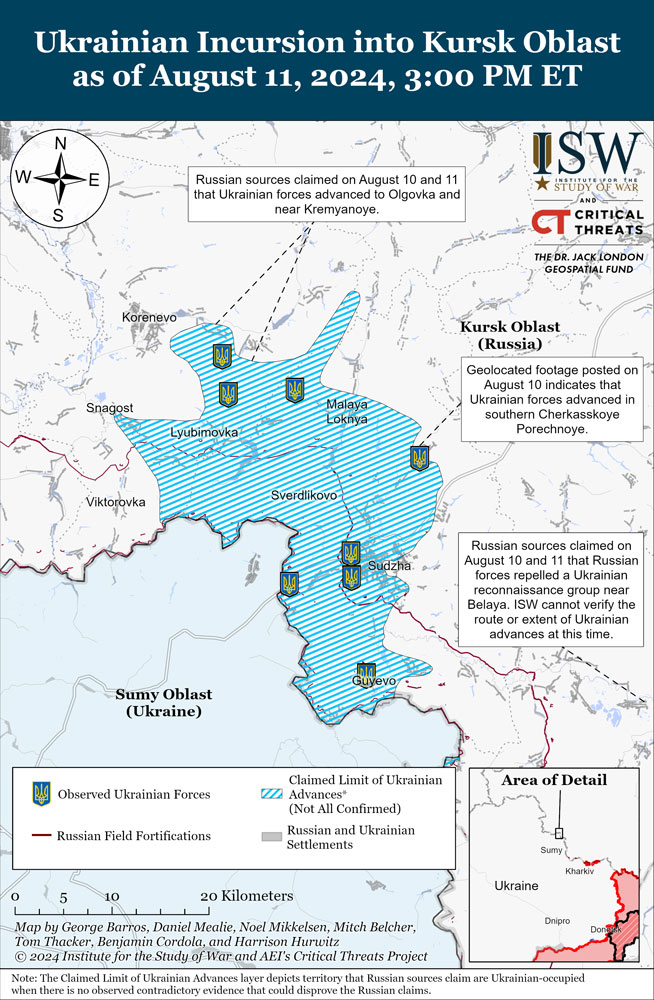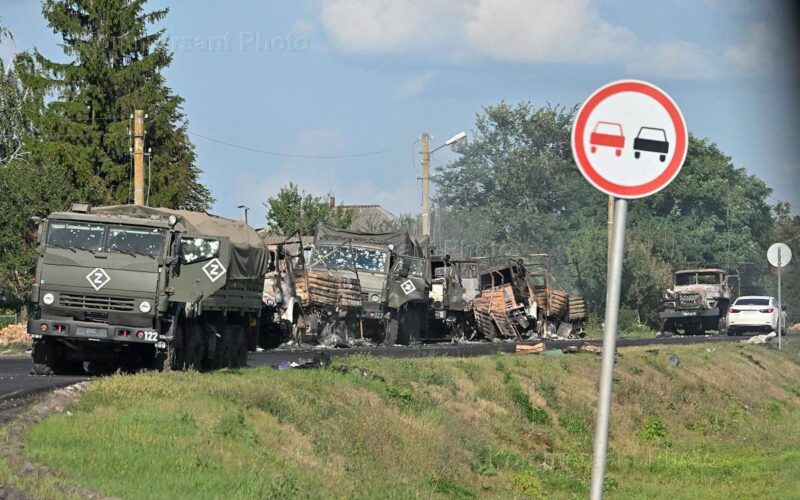"We continue to conduct an offensive operation on the territory of Kursk oblast, currently we control about 1000 square kilometers of the territory of the Russian Federation."

"Thousands" of Ukrainian troops involved in the incursion
The exact number of troops engaged in the operation remains undisclosed, but an unnamed top Ukrainian official told AFP that those number in the "thousands," while footage shows that some of Ukraine's most elite brigades take part in the operation. Ukrainian forces have captured several settlements and secured key infrastructure such as major highways in the area, and a major gas facility outside Sudzha. Additionally, by capturing Sudzha, the Ukrainians cut off a railway line, connecting Kursk's Lgov to Belgorod, which degrades Russia's military logistics in the area. The control of the Sudzha railway station might have given the Ukrainian intelligence access to the databases of the Russian railways. Despite Russian efforts to repel the advance, footage shows Ukrainian forces maintaining control over occupied territories, with no signs of withdrawal. As of the latest reports, Ukrainian forces continue to hold, consolidate, and expand their territorial gains in Kursk Oblast. Forbes notes that the operation has been characterized by a combination of conventional military maneuvers and advanced tactics, including the wide use of electronic warfare and drone strikes. As one of the excuses to the Russian setbacks in Kursk, Russian media and military bloggers mentioned that the border in the area was poorly fortified and insufficient number of defenders. Meanwhile, a Ukrainian Army officer reported that some captured Russian border positions included underground facilities, such as barracks, canteens, and even a gym, now utilized by Ukrainian troops.Possible objectives of the Kursk counter-incursion
Ukrainian officials and the military have remained tight-lipped, with most known details coming from Russian military bloggers. Meanwhile, experts and analysts continue to speculate on the potential goals of the incursion.US seeks to understand goals and strategy of Ukraine’s Kursk incursionTatarigami, OSINT and GEOINT analyst, founder of Frontelligence Insight, suggests that one primary aim is to boost morale, both within Ukraine and among its Western supporters, by demonstrating that Ukrainian forces can still take bold and unexpected actions. The operation has indeed sparked hope and optimism, countering the perception that Ukraine is on the backfoot in the broader conflict. Observers and experts have noted that the operation is probably designed to divert Russian forces from offensive operations in Donetsk Oblast, where the Russians have been making slow but steady progress using frontal attacks and exploiting their "disposable" manpower advantage. The Telegraph adds that the operation could also be intended to create discord within Russia by exposing vulnerabilities in its internal security. The fact that Ukrainian forces have managed to penetrate so deeply into Russian territory has likely shaken the confidence of Russian citizens and could undermine support for the war effort. Former Ukrainian Economy Minister Tymofiy Mylovanov noted that the incursion into Kursk "demonstrates that Russia's nuclear threat is a bluff and renders the entire US Biden administration's doctrine of de-escalation irrelevant." Over the past two years, the US has repeatedly delayed approving various weapons supplies to Ukraine, citing concerns about potential "escalation" by Russia. Shortly after the incursion into Kursk began, Ukraine once again sought US permission to use ATACMS missiles deep into Russian territory, but US officials stated that their policy remained unchanged. Finally, multiple experts suggest that Ukraine may be using the operation to strengthen its position in future negotiations. By holding Russian territory, even temporarily, Ukraine could gain leverage in any potential land swap deals or peace talks, a tactic hinted at by previous discussions within the Ukrainian government. Meanwhile, Mick Ryan, retired Major General from the Australian Army and Senior Fellow for Military Studies at the Lowy Institute, outlines three potential strategic options for Ukraine as they reach their limit of exploitation in the Kursk incursion, each with its own objectives, risks, and potential benefits:
- Option 1: Consolidate and Defend
- Objective: Maintain pressure on Russian sovereignty and create leverage for negotiations.
- Risks: High risk of Ukrainian forces being cut off and suffering significant losses, which could undermine the positive impact of the incursion.
- Option 2: Partial Withdrawal
- Objective: Secure more defensible ground while continuing to threaten Russia and reallocating troops to other fronts.
- Risks: Medium risk, still requires significant effort to fortify positions but reduces the likelihood of heavy losses.
- Option 3: Full Withdrawal
- Objective: Preserve Ukrainian forces for future operations, while demonstrating capability to invade without intent to occupy.
- Risks: Preserves forces and boosts morale, but may reinforce Russian narratives about NATO threats.
Prospects of the operation
Tatarigami warns of the risks associated with overextension. As Ukrainian forces advance, their logistical lines lengthen, complicating the ability to maintain adequate air defense and supply chains. If Russia manages to assemble a counterforce, Ukraine might face a difficult decision between digging in on less favorable ground or withdrawing, potentially questioning the overall value of the operation. Phillips P. OBrien is more optimistic, suggesting that the operation could significantly disrupt Russian military operations and morale. The continued Ukrainian advance, despite Russian reinforcements, indicates a well-executed strategy that could lead to further successes, provided Ukraine maintains its technological and tactical edge.The ongoing operation has yielded an unanticipated consequence: the capture of numerous Russian prisoners of war, including many conscripts. This development may accelerate POW exchanges, potentially allowing more Ukrainian captives to return home from Russian detention sooner than expected.
Electronic warfare as a game-changer
The initial success of the Kursk incursion has been heavily attributed to Ukraine's advanced use of electronic warfare and drones. Forbes details how Ukrainian forces employed jamming technology to neutralize Russian drones, allowing for rapid ground advances. According to Forbes, referring to several Russian sources, Ukrainians first neutralized Russia's reconnaissance drones, likely using new interceptor FPVs linked to air-defense radar, effectively blinding Russian commanders. Under this temporary blackout, they advanced short-range jammers programmed with data from electronic warfare reconnaissance, disrupting Russian communications by targeting key frequencies. Due to the area's low priority and outdated equipment, Russian drones, including FPVs and Lancet loitering munitions, were unable to function effectively. Regarding the broader strategic implications of the Kursk operation, Ryan notes that the operation could signal a shift in Ukraine’s military strategy, where high-risk, high-reward operations become more common as Ukraine seeks to alter the war's status quo. Meanwhile, OBrien emphasizes that the operation challenges conventional wisdom about Russian military strength, potentially inspiring similar strategies in other conflicts.Implications for Russian internal security
The incursion has exposed significant vulnerabilities in Russian internal security, particularly along the border regions. The operation undermines Russian confidence in their military's ability to defend the homeland, leading to increased criticism of the government and military leadership.Bloomberg: Ukrainian incursion in Kursk may challenge Moscow’s political stabilityOn 10 August, Russia announced the so-called counter-terrorism operation (KTO) regime in Kursk, and its neighboring Belgorod and Bryansk oblasts, according to TASS. In essence, it means handing over the control of the military in the area to the FSB security agency.
- Putin demands that the Russian Ministry of Defense “squeeze out the enemy” from the Kursk region
- Ukraine’s surprise Kursk incursion: lifting spirits or stretching resources?
- Frontline report: Ukraine gains more territory in Kursk in 3 Days than Russia in 3 months in Kharkiv
- China urges “de-escalation” on both sides amid Kursk incursion
- ISW: Ukraine’s surprise Kursk incursion exposes gaps in Russia’s strategic planning
- Kremlin downplays Ukrainian incursion into Kursk Oblast — ISW
- US seeks to understand goals and strategy of Ukraine’s Kursk incursion
- Russia declares “counter-terrorist operation” in Kursk, Belgorod and Bryansk oblasts bordering Ukraine
- Bloomberg: Ukrainian incursion in Kursk may challenge Moscow’s political stability
- Forbes: Ukraine’s elite air assault brigade joins ongoing incursion into Russia’s Kursk Oblast
- Satellite images confirm strikes on Kursk aviation and artillery warehouses prior to incursion
- Mixed forces allegedly breach into Russian Kursk Oblast from Ukrainian side

